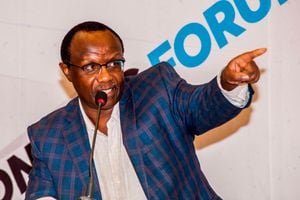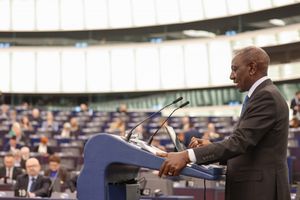Time to ditch ethnic outfits for reformist parties

Nyeri residents are mobilised for a political rally at Dedan Kimathi Stadium in Nyeri on June 11, 2017. PHOTO | FILE | NATION MEDIA GROUP
What you need to know:
- The brand of philosophy, vision and ideology that reform-oriented contestants have espoused has not resonated with the populace.
- Reform candidates time and again are neutralised by coalitions of ethnic blocs. Up to this moment, Kenyans have ceded their votes to their kingpins.
Since Kenya’s re-introduction of multiparty politics in 1991, about 33 “outsider” or “fringe” candidates have vied for the presidency.
For some, the prize was national notoriety while others had solid reform credentials.
During the 1980s and 1990s, the civil society movement mainly comprising NGOs, the intelligentsia and youth activists caught the eye of the Kenyan public due to its role in the struggle for multiparty democracy and the Wanjiku constitution.
Ultimately, however, it was the resurgent political opposition led by former President Mwai Kibaki that in 2002 captured state power.
Indeed, civil society, at the prodding of former Chief Justice Willy Mutunga, Makau Mutua and Maina Kiai of the Kenya Human Rights Commission, endorsed the National Rainbow Coalition (Narc), which had politically accommodated some civil society elements.
Since the political opposition and non-state actors had been comrades in arms agitating for pluralism and constitutional reform, the latter believed once in charge, the new power wielders would expedite constitutional change.
There were those in civil society, led by Rev Timothy Njoya and the youth leadership of the National Convention Executive Council (NCEC) who opposed the civil society slide into politics.
They argued civil society should remain faithful to Wanjiku’s quest for fundamental change in Kenya.
At this historical juncture, the reform movement lost an opportunity to create its distinct political identity.
ELECTIVE POLITICS
Any civil society activist could only join electoral politics through the existing traditional political vehicles.
The second wave of reformers had joined elective politics in 1992, the third significant wave in 2002, the first tide having been in the 1960s.
Kenyans can thus be forgiven for believing that the job of civil society was to champion political change while the duty of the mainstream political class was to discharge power.
Let us examine the following statistics. In 1992, President Daniel arap Moi won the elections with 1,927,645 (36.5 per cent) votes.
Presidential candidates who had reform credentials garnered paltry votes. These were former political detainee David Mukaru Ng’ang’a with 8,527 (0.2 per cent), unrelenting democracy crusader George Anyona 14,253 (0.3 per cent), and Chibule Wa Tsuma 15,393 (0.3 per cent).
In 1997, Moi yet again emerged victorious with 2,500,865 votes (40.4 per cent). A galaxy of top reformers joined the presidential combat.
Prof Wangari Maathai, who later won the Nobel Peace prize, scored 4,246 (0.07 per cent, Koigi wa Wamwere, a long-time detainee and political refugee, had 7,745 (0.13 per cent), Anyona 16,428 (0.27 per cent), Katama Mkangi 23,554 (0.38 per cent), Martin Shikuku 36,512 (0.59 per cent), Stephen Omondi Oludhe 3,691 (0.06 per cent), and Godfrey Mwereria 4,627 (0.07 per cent).
Dr Munyua Waiyaki, who had previously stuck with Jaramogi’s Ford Kenya, garnered 6,194 (0.10 per cent) votes and Kimani Wa Nyoike 8,306 (0.13 per cent).
The only exception to dismal performance by minor reform candidates in 1997 was Charity Kaluki Ngilu, who scored 488,600 (7.89 per cent) votes. She enjoyed a groundswell of support from South-Eastern Kenya.
ETHNIC BLOCS
In 2002, James Orengo scored 24,524 (0.4 per cent) of the presidential vote. In 2007, legendary Kenneth Matiba managed 8,046 (0.08 per cent) votes, although by election time he had withdrawn from the contest.
In 2013, Paul Muite had 12,580 votes (0.10 per cent) in the presidential contest. The indefatigable human rights activist Martha Karua polled 43,881 (0.36 per cent of the vote); Prof James Kiyiapi 40,998 (0.34 per cent) and Peter Kenneth 72,786 (0.60 per cent).
In 2017, John Ekuru Aukot garnered 27,400 (0.18 per cent) and “Mwalimu” Mohammed Abduba Dida 38,004 (0.25 per cent) of the vote.
The brand of philosophy, vision and ideology that reform-oriented contestants have espoused has not resonated with the populace.
Most have offered their candidature pretty much on their own without support by any coherent movement(s) or campaign network and resource base.
However, reform candidates time and again are neutralised by coalitions of ethnic blocs. Up to this moment, Kenyans have ceded their votes to their kingpins.
What a party stands for is secondary so long as a sufficient number of ethnic barons combine to swing the presidential election. Elections based on ethnic arithmetic annul the realisation of change-based or transformational leadership.
One may ascribe the poor performance of tested reformers to electoral malpractice and voter apathy.
Usually, a sizeable number of eligible voters don’t register to vote, believing their vote does not count. Others who register do not vote.
NATIONAL CHARACTER
In 1969, 1983 and 1988 for example, voter turnout was 44.6 per cent, 45.9 per cent and 40.7 per cent, respectively. More than half of the voters abstained, thus “voting” for the status quo.
Are we possibly witnessing the demise of ethnic-based politics? Is there any hope that politicians committed to broad-based and reform-inclined politics could enter the national stage? Is the reform or change bug then likely to capture the country’s imagination?
Possibly, the political class is waking up to the reality that the current ethnic coalitions tend to produce two groups of near equal strength, rendering presidential elections, by and large, inconclusive.
Results are routinely contested as was the case in 2007, 2013 and 2017. A mechanism for unlocking this strife-prone impasse must be found.
And critically, reformers must find space in the political arena. No wonder the current national discourse concerns re-engineering our politics and society.
Historically, the five political parties that have had a modicum of national character are Kanu of independence, the original Ford, Narc, Jubilee Party and ODM.
Unfortunately, these don’t enjoy longevity due to collapse of their tribal foundations. The current 68 political parties can easily be merged into three or so main political formations based on ideological orientation.
Ethnicity-based political outfits are, therefore, temporary, fragile and conflict ridden. Our citizens seem to yearn for a paradigm shift in our political and societal organisation. The political road to 2022 may be the one less travelled.
Prof Kibwana is the governor of Makueni County





